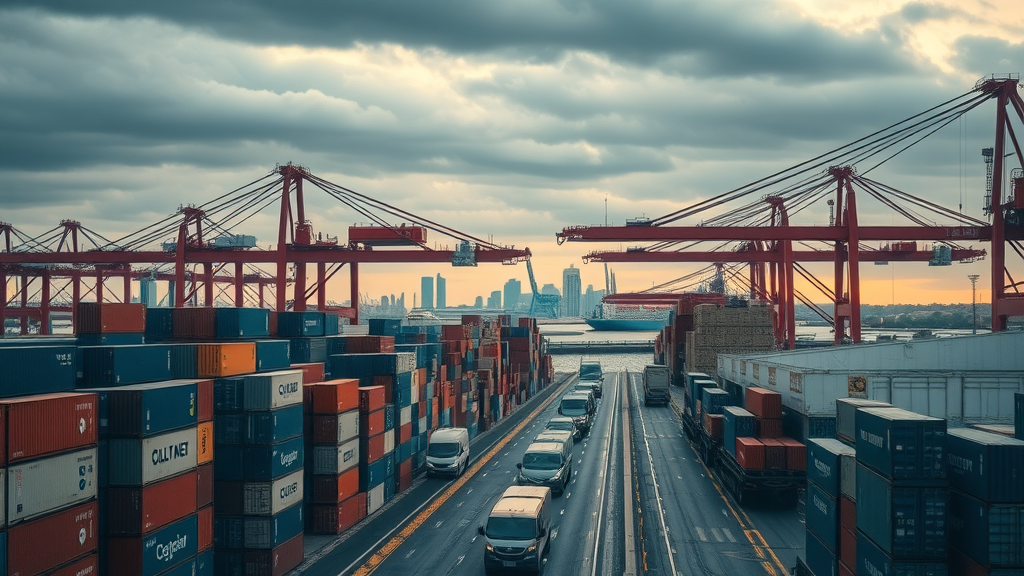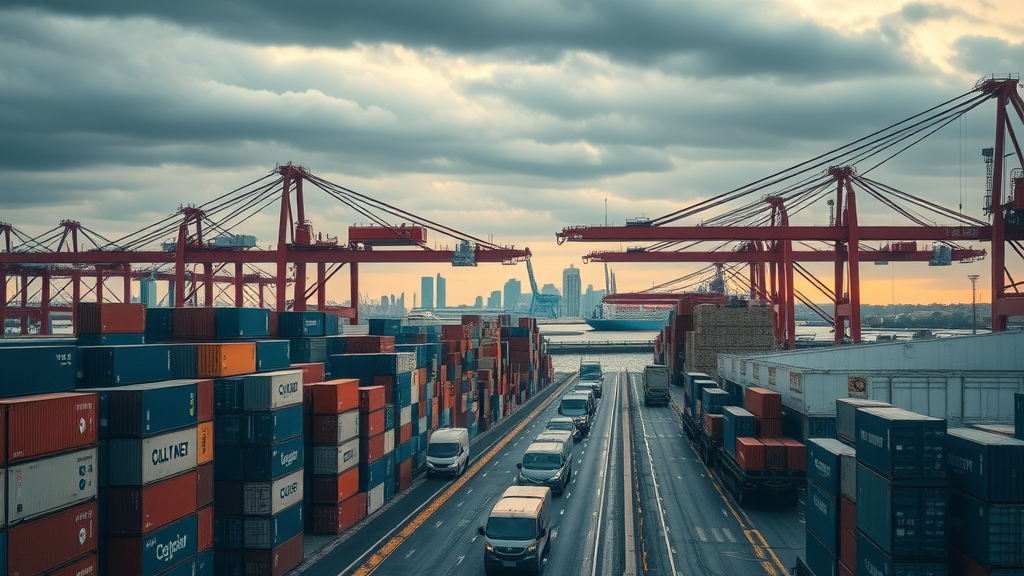Did you know that nearly 40% of global companies reported direct disruptions to their supply chains in 2023 due to shifting tariffs and changing international trade rules? As uncertainty becomes the new normal, both small businesses and multinational corporations find themselves scrambling to keep their global supply chains intact. If you've felt the ripple effects—whether in the form of cost increases, operational headaches, or shifting supplier choices —this editorial will deliver fresh perspective and practical insight on how the interconnected web of tariffs and supply chains directly impacts your business and what the future may hold for trade war survivors across the globe.
Let’s pull back the curtain and take an honest look at why tariffs and supply chains have become inseparable in today’s heated global trade debates. Think your business is immune? Read on—because every link in the chain matters.
Tariff and Supply Chains: Revealing the Startling Impact on Global Supply Chain Dynamics
"In 2023, nearly 40% of global companies reported direct disruptions to their supply chains due to changing tariffs and trade regulations."

The influence of tariffs on global supply chain dynamics is immediate and far-reaching. As governments introduce or adjust trade barriers—ostensibly to protect domestic industries or respond to diplomatic tensions— supply chains across sectors must quickly adapt. Businesses face operational shocks , including abrupt cost increases, rerouted supply lines, and sudden shortages of vital raw materials. These shocks often cascade along the entire supply chain, forcing rapid redesigns in sourcing, manufacturing, and logistics processes.
What is often overlooked in public debates is the long-term impact of trade war policies . Over time, tariffs can force organizations to rethink the fundamentals of their global supply chain design. Many manufacturers, for example, accelerate supplier diversification efforts or shift their production hubs to alternative countries to mitigate risk. Meanwhile, the ongoing uncertainty surrounding trade agreements prompts a visible shift in global trade partnerships—with companies seeking stability wherever they can find it, from free trade zones to newly fortified regional alliances.
Recent tariff shocks have not only significantly impacted economic activity but have also altered the fabric of global trade. As businesses grapple with increased lead times and unpredictable costs, the supply chain has become a tactical battleground where strategic choices determine not just profitability, but survival.
- Immediate operational shocks and uncertainties
- Long-term supply chain design reconsiderations
- Shift in global trade partnerships
Why Tariff and Supply Chains are Inseparable in Global Trade Debates
The debate about tariffs is inseparable from that about supply chains—especially in the era of global trade and supply chain management . High tariffs, intended to protect domestic industries or retaliate in a trade war, ultimately disrupt supply chains, making the cost of imported goods less predictable and harming global economic activity.
With each new tariff announcement, multinational businesses must recalculate costs and redesign workflows. Tariff shocks often force companies to reduce tariff exposure by moving assembly lines, adjusting supplier contracts, or investing in alternative sourcing strategies. What’s more, the relentless march of globalization means that even companies not directly involved in international trade can feel the potential impact of tariffs when input costs rise or supply lines are disrupted.
How the Modern Supply Chain Reacts to High Tariffs and Trade War Policies
- Relocation of production hubs
- Supplier diversification
- Increased lead times
- Cost-push inflation

High tariffs drive a strategic reassessment of supply chain networks. Many firms proactively move production away from tariff-affected regions—a familiar narrative since the United States imposed tariffs on Chinese imports, causing companies to establish operations in Vietnam, Mexico, or Eastern Europe. Simultaneously, supplier diversification becomes an urgent priority, lowering dependency on a single country or region.
Another side effect of trade war disruptions: increased lead times . Customs delays, longer transport routes, and more complex compliance requirements all contribute to a slower, less flexible supply chain. As businesses adapt, the downstream effect is often cost-push inflation , with end users bearing the brunt of higher prices for finished products, from smartphones to automobiles.
The scramble to adapt often inspires upgraded supply chain management practices, particularly investments in digital tools and supply chain visibility. These enable quicker reaction to sudden shifts in trade agreements or regulatory environments—making agility the new gold standard in global supply chain strategy.
Global Supply Chain Under Siege: Tariff and Supply Chains Challenges Faced by Businesses
Tariffs and volatile trade policies have placed global supply chains under siege. Businesses are forced to navigate both immediate disruptions and the complex task of redesigning their operational models for long-term resilience. The impact of tariff shocks is being felt in unacceptable production delays, higher prices for raw materials and finished goods, as well as instability in established trade agreements .
The challenges grow when sectors rely on specific partners or components, such as crude oil, semiconductors, or industrial machinery, whose supply lines are easily disrupted by new tariffs or policy changes. This vulnerability has amplified the importance of a robust, flexible approach to supply chain management , where contingency planning and network diversification are becoming standard practice.
In real-world scenarios, businesses face choices that come with significant cost increases, lost market share, or both. The global supply chain is now a high-stakes arena with winners and losers determined by adaptability, foresight, and strategic investment.
Case Studies: Trade War Consequences for Global Supply and Demand
| Company | Impact of Tariff | Supply Chain Response |
|---|---|---|
| XYZ Corp (Auto) | Raised costs by 18% | Shifted sourcing to Vietnam |
| Alpha Electronics | Production delays | Dual sourcing strategies adopted |
| Textile Global | Increased lead times | Established local manufacturing |

These cases illustrate the hard choices companies must make in the face of trade war consequences. From automotive giants grappling with an 18% cost increase due to tariffs, to electronics firms facing serious delays as new regulatory checks choke supply lines, the response has been swift. Businesses shift sourcing strategies, invest in local manufacturing, or establish alternative regional supply chains to reduce their exposure to tariff shocks and maintain market presence.
Supply chain shocks do not just affect individual companies—they reverberate through entire sectors. When one company relocates production or pivots to dual sourcing, competitors must follow suit, creating a domino effect throughout the market and the global trade system. In this context, adaptability and risk management are prerequisites for survival.
Exploring the Global Trade Web: How Global Supply Chains Adapt Under High Tariffs
The web of global supply chains is constantly evolving, especially under high tariff environments. The "old rules" of just-in-time manufacturing and lowest-cost sourcing are giving way to new playbooks focused on resilience, agility, and technological innovation . As a result, the roles of supply chain managers and strategists are being redefined, as they look for ways to reduce risk and improve efficiency in an evolving global landscape.
Across industries, the focus is turning to regional supply hubs, enhanced digital oversight, and the embrace of nearshoring trends . These adaptations not only address the risk of tariff shocks but also improve responsiveness to sudden demand changes or new trade regulations. The lesson is clear: true global supply chain resilience hinges on agility, transparency, and the ability to pivot quickly in the face of external shocks.
As new disruptions—from geopolitical strife to pandemic-driven demand spikes—continue to emerge, organizations that invest early in digital transformation and network diversification will gain a sustainable advantage in global trade.
Lessons from the U.S.-China Trade War: The Ripple Effect on Global Supply
- Supply chain resilience
- Digital transformation
- Nearshoring trends

The protracted U.S.-China trade war offers vital lessons for the rest of the world. First and foremost, maintaining a resilient supply chain isn't just about cost savings—it's about survival during uncertainty. The biggest winners of the trade war have been those companies that invested in supply chain flexibility, such as implementing robust supplier networks and embracing predictive digital analytics.
Furthermore, nearshoring —the relocation of production closer to the target market—has grown, especially for industries requiring fast turnaround or highly customized finished products. Digital transformation initiatives, such as blockchain or real-time tracking, now form the backbone of next-generation supply chain management.
These strategic pivots enable companies to better manage supply and demand shocks, whether they're triggered by new tariffs or unforeseen crises like a global pandemic. The lesson here: as the rules of international trade keep changing, so must the rules of supply chain strategy.
Opinion: Are Tariffs the True Villain in Supply Chain Disruption or Are There Deeper Issues?
"While tariffs grab the headlines, logistical bottlenecks and lack of diversification have also magnified supply chain vulnerabilities."
Are tariffs really the primary cause of global supply chain disruption? In my view, while tariffs are a major disruptor, blaming them exclusively ignores deeper, systemic issues. Even in the absence of new tariffs, fragile or overly concentrated supply chains can quickly buckle under stress—be it from natural disasters, labor shortages, or unexpected policy changes.
Too often, businesses overlook the compounding effects of logistical bottlenecks and the dangers of single-source dependency. It’s not just the cost of imported goods or raw materials that rises; it’s the risk of being unable to deliver products or fulfill contracts on time. The real risk lies in a supply chain not built for agility or diversity—a problem that even the best trade agreements or a reduction in tariffs cannot solve overnight.
The next true leap in global supply chain management demands a focus not just on reacting to tariffs, but on strengthening resilience at every link, ensuring that companies can thrive in any economic or geopolitical climate.
External Factors: Beyond Tariff and Supply Chains – Geopolitics, Pandemics, and Labor Shortages
- Political instability
- Pandemic-driven demand shocks
- Labor and material shortages
Recent history, from Brexit to the COVID-19 pandemic, highlights the power of external factors in shaping supply chain vulnerabilities. Political instability and sudden regulatory shifts can halt production overnight, while pandemics create erratic demand spikes and severe labor shortages. Add material shortages—everything from crude oil to computer chips—and you have a perfect storm that no single policy can fix.
These factors remind us that global supply chain risk is multifaceted. Preparing for tariff shocks is only one piece of the puzzle; businesses must also develop strategies for dealing with the full spectrum of international risk. The intersection of politics, health, and technology has permanently altered expectations for what defines "normal" in global commerce.
Ultimately, the companies that adapt proactively—by diversifying suppliers, investing in workforce resilience, and digitalizing operations—will be best prepared for the uncertainties that accompany global trade.
Strategies to Mitigate the Impact of Tariff and Supply Chains Issues
Forward-thinking organizations don’t just react to tariffs and global trade restrictions—they actively prepare for future shocks through strategic planning. Leaders in supply chain management now emphasize risk diversification and digital transformation as core tenets in their playbook for resilience. Multiple-source strategies, robust visibility across the supply chain, and integrating regional trade agreements are now standard weapons in a company's arsenal.
Global trade volatility isn't going away anytime soon, so companies future-proof their operations by ensuring their supply chain is responsive, diverse, and technologically enabled. The adoption of digital tools—from AI-powered demand forecasting to blockchain-based traceability—makes it easier to identify potential risks and act quickly when conditions change.
Moreover, strengthening ties within regional trade blocs can provide a safety net against the unpredictability of global trade wars. By shifting towards localized or nearshored supply chains, businesses can reduce exposure to high tariffs, improve speed to market, and maintain greater control over quality and compliance.
Diversification and Digitalization: The Future of Global Supply Chain Management
- Building multi-source supply strategies
- Investing in supply chain visibility tools
- Emphasizing regional trade agreements

A future-proof global supply chain depends on two critical strategies: diversification and digitalization . Companies now recognize that relying on a single supplier or region is a recipe for disaster. Instead, they are building multi-source networks, often with alternative partners in different countries.
Visibility is equally critical. Investing in advanced supply chain management platforms gives businesses real-time data on inventory, shipment status, and emerging risks, enabling faster response to tariff or non-tariff disruptions. Finally, participating in regional trade agreements helps circumvent some of the volatility found in global trade, creating stability and predictability in the face of external shocks.
Video Analysis: The Global Trade War’s Effect on Supply Chains
Industry Expert Panel: The Long-term Effects of Tariffs on Supply Chains
Watch thought leaders dissect the global ripple effects of the ongoing trade war, highlighting lessons and strategies for sustainability and supply chain resilience.
Video Guide: Practical Solutions for Businesses Facing Tariff and Supply Chain Problems
Step-by-Step Advice: This easily digestible guide offers actionable strategies for companies grappling with the latest tariff shocks and supply chain blockages—from mapping critical vulnerabilities to leveraging automation for improved agility.
What You'll Learn from This Tariff and Supply Chains Discussion
- The interplay between tariffs, supply chains, and global trade
- Real-world consequences for businesses facing tariff shocks
- Actionable approaches to future-proof your global supply chain

People Also Ask: Tariff and Supply Chains FAQ
How do tariffs affect the supply chain?
Tariffs raise the cost of importing goods, causing supply chain disruptions by increasing expenses for raw materials and finished products. This often results in companies shifting suppliers or production to other countries, lengthening lead times, and passing increased costs on to consumers. Ultimately, tariffs can significantly impact both the structure and resilience of global supply chains.
How tariffs shock the supply chain?
Tariff shocks are sudden changes in trade policy that force businesses to adapt rapidly. They can lead to abrupt increases in production costs, delayed shipments, and even shortages of crucial components. These shocks challenge the efficiency and stability of supply chains, pressuring organizations to diversify sources swiftly or adopt new supply solutions.
What are the 4 types of tariffs?
The four main types of tariffs are ad valorem tariffs (a percentage of the item's value), specific tariffs (a set amount per unit), compound tariffs (a mix of ad valorem and specific), and retaliatory or countervailing tariffs (designed to offset subsidies or perceived trade injustices by other countries). Each type has a different impact on international trade and supply chains.
Do tariffs decrease supply or demand?
Tariffs typically decrease demand for imported goods by raising their prices, making domestically produced alternatives more attractive. While supply may shrink if imports become too expensive or hard to find, the primary effect is usually seen in decreased consumption or demand. However, long-term trade restrictions can affect both supply and demand, depending on how businesses and consumers adapt.
Frequently Asked Questions on Tariff and Supply Chains in Global Trade
-
How can companies forecast tariff risks?
Companies can use predictive analytics, monitor geopolitical trends, and maintain close relationships with customs and trade experts to anticipate potential tariff changes and plan accordingly. -
What industries are most vulnerable to global trade wars?
Industries that rely heavily on cross-border supply chains—like automotive, electronics, textiles, and agriculture—face the highest risk during trade wars due to their dependence on imported raw materials and finished components. -
Is reshoring a sustainable supply chain strategy?
While reshoring can increase supply chain stability and reduce tariff exposure, it may not always be cost-effective. A balanced strategy often combines reshoring with nearshoring and supplier diversification. -
How do digital tools help manage supply chain complexity?
Digital tools offer real-time visibility, predictive analytics, and automation, helping companies monitor risks, track shipments, and manage supplier relationships more efficiently throughout the global supply chain.
Key Takeaways: Navigating Tariff and Supply Chains in the Era of Global Trade Disruption
- Tariffs are a key disruptor, but so are unforeseen global events.
- Anticipating change is as crucial as reacting to it.
- Digitalization and network diversification are indispensable for resilient global supply chains.
Final Thoughts: Shaping the Future of Tariff and Supply Chains in Global Supply Chain Resilience
"Disruption is inevitable, but resilience is a choice — the companies that adapt fastest will thrive amid trade turbulence."
Take bold steps: embrace digital innovation, diversify your network, and anticipate the next global shift—this is how you'll stay ahead in the ever-changing landscape of tariff and supply chains.
Ready to Share Your Perspective on Global Trade?
Got Something to Say About Global Trade? RP Design Web Services can put your insights on Global Trade Notes in front of the right audience. Call 203-271-7991 today and get your word out.
Tariffs and supply chains are deeply interconnected, with recent developments highlighting their significant impact on global trade. For instance, President Trump’s tariffs have compelled companies to reevaluate their supply chains, especially with new levies on pharmaceuticals looming. Even firms with a strong U.S. presence, like Avon Technologies, anticipate substantial tariff costs, despite securing significant contracts such as an $18 million order from the U.S. military. This situation underscores the necessity for businesses to adapt their supply chain strategies in response to evolving trade policies. ( ft.com )
Additionally, the concept of “friendshoring” has emerged as a strategy where companies and governments prioritize manufacturing and sourcing from geopolitical allies to mitigate risks associated with tariffs and trade tensions. This approach aims to maintain access to international markets while reducing geopolitical vulnerabilities, though it may lead to increased manufacturing costs and potentially lower economic output. ( en.wikipedia.org )
Understanding these dynamics is crucial for businesses aiming to navigate the complexities of global trade effectively.
 Add Row
Add Row  Add
Add 




Write A Comment